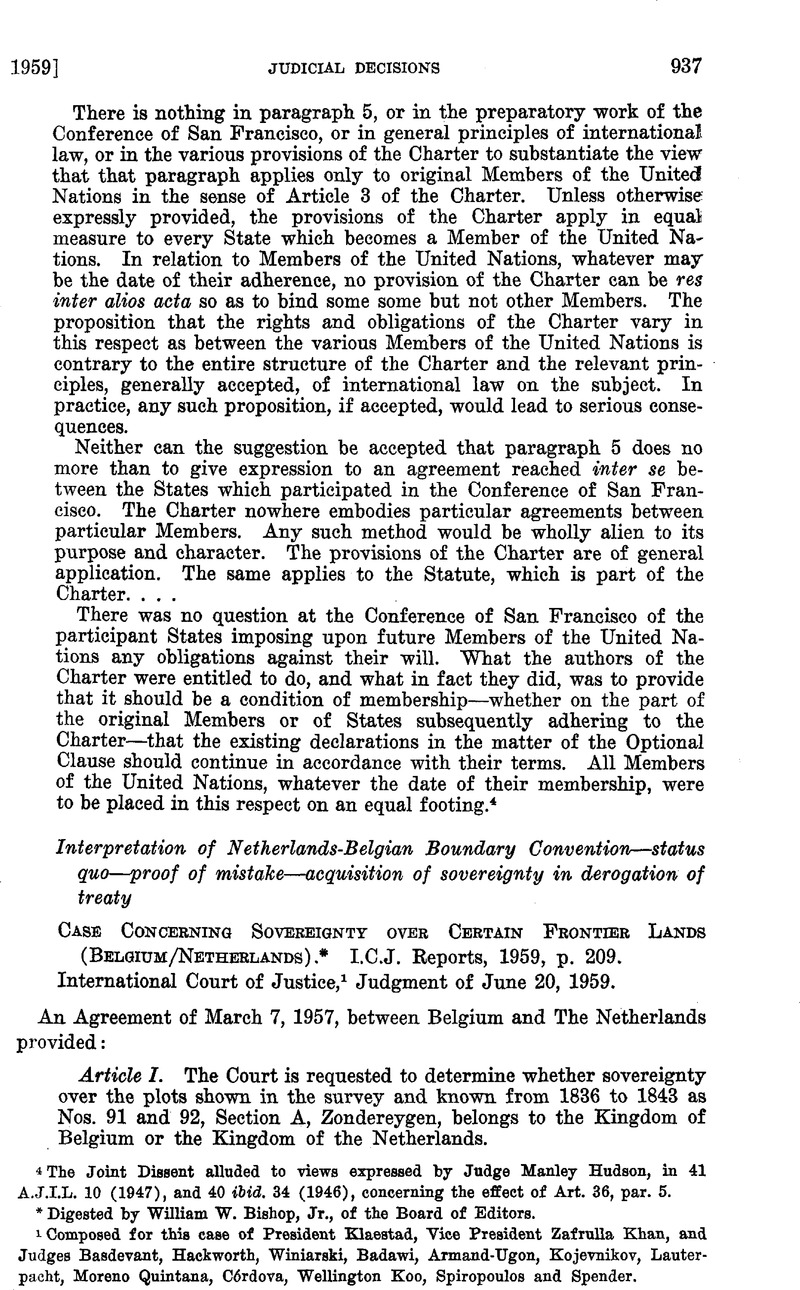Published online by Cambridge University Press: 28 March 2017

Digested by William W. Bishop, Jr., of the Board of Editors.
* Digested by William W. Bishop, Jr., of the Board of Editors.
1 Composed for this case of President Klaestad, Vice President Zafrulla Khan, and Judges Basdevant, Haekworth, Winiarski, Badawi, Armand-Ugon, Kojevnikov, Lauterpaoht, Moreno Quintan;!, C6rdova, Wellington Koo, Spiropoulos and Spender.
2 About 14.378 hectares or 35 acres in area.
3 Judge Lauterpacht said: ‘’ The circumstances of the adoption, in 1843, of the Descriptive Minute must, to some extent, be in the nature of conjecture. In particular, it has not been proved possible to state a direct conclusion as to the authenticity or otherwise of the cardinal piece of evidence, namely, of the only existing copy of the Communal Minute produced by the Netherlands. Moreover, while the Commissioners who drafted the Descriptive Minute enjoyed wide powers, they had no power to endow with legal efficacy a document in which they purported to transcribe word for word the Communal Minute and to observe the status quo but in which they actually modified the Communal Minute and departed from the status quo. The law knows of no such power. For these reasons, I am of the opinion that the relevant provisions of the Convention must be considered as void and inapplicable on account of uncertainty and unresolved discrepancy. ” … it seems proper that a decision be rendered by reference to the fact, which is not disputed, that at least during the fifty years following the adoption of the Convention there had been no challenge to the exercise, by the Government of the Netherlands and its officials, of normal administrative authority with regard to the plots in question. In my opinion, there is no room here for applying the exacting rules of prescription in relation to a title acquired by a clear and unequivocal treaty; there is no such treaty. It has been contended that the uninterrupted administrative activity of the Netherlands was due not to any recognition of Netherlands sovereignty on the part of Belgium but to the fact that the plots in question are an enclave within Netherlands territory and that, therefore, it was natural that Netherlands administrative acts should have been performed there in the ordinary course of affairs. However, the fact that local conditions have necessitated the normal and unchallenged exercise of Netherlands administrative activity provides an additional reason why, in the absence of clear provisions of a treaty, there is no necessity to disturb the existing state of affairs and to perpetuate a geographical anomaly.“
4 Judge Spiropoulos found the status of the plots ‘ ‘ extremely doubtful'’ and preferred the Dutch hypothesis, which he thought “the less speculative.“
5 Judge Armand-TJgon pointed to the Communal Minute as “of cardinal importance,'' and said that Belgium could not explain the absence of its original, but did not challenge the authenticity of the Dutch original. He thought the records of the Mixed Boundary Commission showed the clear intention to adopt the Communal Minute without alteration on the relevant point, particularly as there was no evidence in the records of any intention to make ‘this change and deliberately award the plots to Belgium. He added that: “For almost one hundred years the Convention of 1843 was applied in a manner which does not conform with the text of the Communal Minute included in Article 90 of the Descriptive Minute; although that article regards the plots as Belgian, these same plots have actually been submitted to Netherlands sovereignty.” Only in 1890 was the divergence apparently raised by Belgium. He further stated that ‘ ‘ the Netherlands Government has exercised preponderant governmental functions in respect of the disputed plots, without these having given rise on the part of the Belgium Government to any protest or any opposition. This prolonged tolerance of the Belgian Government in this respect has created an indisputable right of sovereignty in favour of the Netherlands Government. There is no evidence that Belgium claimed restitution of the parcels before 1921, or that any Belgian activities occurred thereon.“
6 Judge Moreno Quintana regarded the question as one of interpretation of the Boundary Convention, since the real intention of the parties should control. Finding a mistake in the “transcription” of the Communal Minute in Article 90 of the Descriptive Minute of the Boundary Convention, he said: “ A mistake of fact—as the most qualified writers in international law teach us—vitiates the consent of the Parties to a legal instrument such as a treaty. This defect in consent involves the total or partial nullity of the instrument in question.” This nullity was confined to the provision concerning these two plots in question.